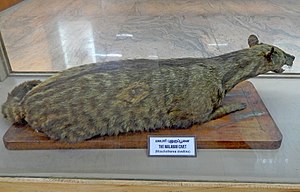Malabar civet
| Malabar civet | ||||||||||||
|---|---|---|---|---|---|---|---|---|---|---|---|---|

Preparation of the Malabar civet |
||||||||||||
| Systematics | ||||||||||||
|
||||||||||||
| Scientific name | ||||||||||||
| Viverra civettina | ||||||||||||
| ( Blyth , 1862) |
The Malabar civet cat ( Viverra civettina ) is an extremely rare or already extinct species of predator from the family of the crawling cats (Viverridae). The species occurs or was found in a small area in southwest India and was previously mostly regarded as a subspecies of the great spot civet . Today it is considered an independent species. After the acquisition of two fresh pelts in 1987 and 1990, the hope was nourished that this species still existed. Unsuccessful search expeditions since 2006 led the Zoological Society of London to suspect in 2013 that this species is probably extinct.
description
The Malabar civet is similar to the large spot civet, although it is slightly smaller. The head body length is 76-85 cm, the tail length 30-40 cm. The body weight is 6.6–8.0 kg. Like the large spot civet, the color is gray to yellow-brown with black spots on the flanks and thighs. The spots are relatively large. Both species have a black topline and a black ringed tail. The striking black and white bands in the neck area are also common to both species. The feet are brownish. Clear differences can be seen in the morphology of the balls of the feet. The skin around the balls of the feet is also bare, while it is hairy in the large-spot civet. The molars are larger than those of the great spot civet.
Tooth formula:
distribution and habitat
Most recently, the Malabar civet was only found in a small area in the Western Ghats in southwest India, especially in the coastal areas between Kanyakumari in the south to Wayanad , Coorg and Honnavar in Karnataka in the north. Here she lives in wetlands and forests, but also in plantations. Only a few records come from areas above 600 m.
Systematics
The Malabar civet was until recently considered a subspecies of the great spot civet. Today both are considered separate species. However, the species status has not yet been confirmed.
Way of life
Little is known about the way of life of this species. The animals seem to be predominantly nocturnal and presumably live solitary. Apparently, Malabar civets are mostly on the ground. Almost nothing is known about their feeding and reproductive habits.
Danger
The Malabar civet is classified as critically endangered by the IUCN . There are no protected areas in their range. A future establishment of protected areas in the region is unlikely due to the dense settlement. In-depth studies of the hazard situation and captive breeding are seen as the best protection strategies.
Originally the Malabar civet was quite common in some areas. In the 20th century, the stocks shrank sharply. In 1978 the species was declared "probably extinct" by the IUCN. Between 1950 and 1990 there were only two - and moreover unsecured - evidence. It was not until 1987 and 1990 that the skins of animals that had been killed shortly before became known. This raised hopes that the Malabar civet cat might still exist. During a large-scale search expedition by AMA Nixon and Siddharth Rao between April 2006 and March 2007, intensive fieldwork was carried out in the districts of Ernakulam, Trivandram, Thrissur, Palakkad, Malappuram, Kozhikode, Kannur, Kasargode, Wayanad, Kollam and Pathinamthitta in the state of Kerala as well as in the districts of Kerala Kodagu, Dakshina Kannada, Uttara Kannada, Udupi, Shimoga and Chikmangalur in the state of Karnataka . No evidence of a continuation of this species could be provided.
literature
- ^ Rao, S., Ashraf, NVK and Nixon, AMA (2007). Search for the Malabar Civet Viverra civettina in Karnataka and Kerala, India, 2006-2007. Small Carnivore Conservation 37: 6-10.
- ↑ Kounteya Sinha: British conservationists say the Malabar Civet may have become extinct In: The Times of India, May 17, 2013, accessed May 17, 2013. Online version
- ↑ a b c d J. S. Gilchist, AP Jennings, G. Veron, (2009). Family Viverridae (Civets, Genets and Oyans). In: Don E. Wilson, Russell A. Mittermeier (eds.): Handbook of the Mammals of the World. Volume 1: Carnivores. Lynx Edicions, 2009, ISBN 978-84-96553-49-1 , (p. 211).
- ↑ a b c d Viverra civettina in the endangered Red List species the IUCN 2011. Posted by: Jennings, A., Veron, G. & slipway, K., 2008. Accessed January 6, 2012th


